Room number
A room number is a number assigned to a room within a building. Its purpose is to identify a particular room, and help building inhabitants locate that room.[1] Logical and consistent assignment of room numbers is important for efficient everyday building usage, and to allow emergency personnel to quickly and easily find their way to any area of a building.
Room numbers may consist of three digits, but can be any number of digits. The room number is generally assigned with the first digit indicating the floor on which the room is located.[2][3] For example, room 412 would be on the fourth floor of the building; room 540 would be on the fifth floor. Buildings that have more than nine floors will have four digits assigned to rooms beyond the ninth floor. For example, room 1412 would be on the 14th floor.
The second digit may represent the wing, or section, of the building in which the room is located: room 540 will typically be found adjacent to room 542, and room 532 adjacent to room 530. In a four digit room number, this digit will be the third digit instead of the second.
The third digit is often assigned based on the side of the corridor on which the room is located: one side of the corridor has odd-numbered rooms and the opposite side has even-numbered rooms. However, numbers may also proceed in an ascending manner on one side of the corridor before switching to the opposite side to continue doing so on that side. In four digit room numbers, this digit will be represented by the fourth digit instead of the third. Where a room is subdivided, the rooms which are accessed after entry into the primary room number are denoted by appending a letter suffix to the next room: for example, after entering room 412 doors which lead to other rooms from within room 412 will be labeled 412A, 412B, and so on. This is known as the Parent-Child Room Numbering system. The room which is entered first is known as the Parent Room. Rooms accessed after first passing through the Parent Room are Child Rooms.
A letter may appear before the numbers to indicate a particular building or wing. For example, Room D149 is a room in D building.
An offset may be used to accommodate unnumbered floors. For example, in a building with floors labeled G, M, 1, 2, ..., 11 and 12, the 4th room in each of those floors could be numbered 104, 114, 124, 134, ..., 224, and 234, respectively — with an offset of 11 in the floor numbers. This trick is sometimes used to make the floor number slightly less obvious, e.g. for security or marketing reasons.
Apartment numbers
Some apartments are numbered using the regular room number assignment method, where apartment 1412 will be the 12th room on the fourteenth floor. Some apartments, however, are assigned with a number followed by a letter. There may be one or two numbers in the apartment number, followed by just one letter. For example, apartment 14R would be on the fourteenth floor. Apartment 7B would be on the seventh floor. Some apartment buildings may use compass points or the letters F, C, or R to indicate the front, center, or rear apartment on a given floor, or a combination of the two. For example, apartment 4RS would be on the 4th floor, and is the south apartment in the rear of the building.
Some apartment complexes use the first digit or first two digits to indicate the building instead of the floor, and the second or third digit to indicate the floor. For example, an apartment complex with 15 buildings might have the buildings numbered 1–15, or 100–1500 in multiples of 100. An example of an apartment number would be 412—on the first floor (1) of building 4 or building 400, or 1204—on the ground floor (0) of building 12 or building 1200.
Denmark
Apartments are usually numbered using the floor number postfixed with the "side" designation, where the floor numbers go st. (ground floor), 1., 2., 3. etc and the post-fix "tv" (to the left), "mf" (in the middle) or "th" (to the right).
Example address: Streetname 123, 2.th, which translates to the second floor (or third floor American style) to the right.
The side can be skipped if there's only one apartment on that given floor.
References
- ↑ Carpman, Janet R.; Grant, Myron A. (2016-06-20) (in en). Design That Cares: Planning Health Facilities for Patients and Visitors. John Wiley & Sons. pp. 8. ISBN 978-0-7879-8811-1. https://books.google.com/books?id=PCfvCQAAQBAJ&newbks=1&newbks_redir=0&lpg=PA80&dq=%22Room%20number%22%20%22floor%20number%22%20architecture&pg=PA80#v=onepage&q=%22Room%20number%22%20%22floor%20number%22%20architecture&f=false.
- ↑ Liebing, Ralph W. (1999-09-13) (in en). Architectural Working Drawings. John Wiley & Sons. ISBN 978-0-471-34876-4. https://books.google.com/books?id=vzC993CYiOsC&newbks=1&newbks_redir=0&lpg=PA55&dq=%22Room%20number%22%20floor%20numbering%20architecture&pg=PA55#v=onepage&q=%22Room%20number%22%20floor%20numbering%20architecture&f=false.
- ↑ Seidler, Douglas R. (2013-10-10) (in en). Revit Architecture 2014 for Designers. A&C Black. pp. 62. ISBN 978-1-60901-482-7. https://books.google.com/books?id=mSQiAgAAQBAJ&newbks=1&newbks_redir=0&lpg=PA62&dq=%22Room%20number%22%20floor%20numbering%20architecture&pg=PA62#v=onepage&q=%22Room%20number%22%20floor%20numbering%20architecture&f=false.


